Around the start of the pandemic, Damion Silver was working on a sculpture in his studio when he noticed that the shadows cast on the floor made interesting patterns. That was when he got the idea to make cyanotypes using maquettes — small-scale mock-ups of his sculptures.
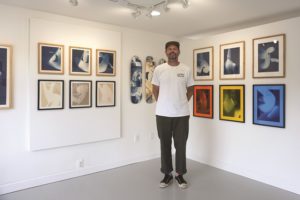
“The juxtaposition of the sculptures to the print, the print to the sculpture — that symbiotic nature — was energizing,” Silver says. He called that early series Remainders because it depicted the sculptures’ negative space. As light is involved, it’s always an experiment, and one ends up with some “really bad ones,” Silver admits. “Over the past year and change, I’ve just gone a little crazy with it.”
A selection of Silver’s cyanotypes — as well as some of his sculptures and skate decks — are currently on view at Longstreet Gallery in Eastham. The show also features works by Kenji Nakayama, as well as collaborations between the two artists, who met while working at Converse. Silver’s day job is associate creative director of sport-style footwear.
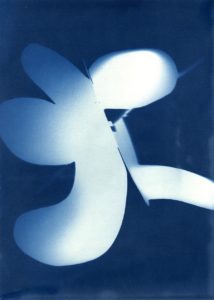
Silver lives in East Kingston, N.H., south of Exeter. He is originally from New Britain, Conn., but went to school in Bristol. “I grew up skateboarding, and I still skateboard,” says Silver. “I just built a ramp in my yard and my son rides a scooter and skateboards. So, skateboard graphics have always played a strong part in my brain and my wiring.” Silver was also influenced by street art and graffiti early on.
“I got introduced to graphic design when I was 14, a freshman in high school,” says Silver. “There was a graphic arts class with a press. The teacher, Mr. Daley, taught silkscreen. That appealed to me because I always wanted to make my own T-shirts. There was something about that application of art that was accessible and had shades of Andy Warhol.”
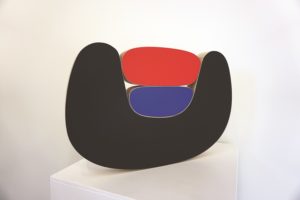
Though Silver went to school for graphic design, he always wanted to do fine art. “Or, at least I thought I did,” he says. “Truthfully, I didn’t know too many living artists who only did that. I was probably well into my 20s when I met Bryan Nash Gill, who was a full-time artist. He did printing, sculpture, and painting. In retrospect, he was very inspirational.”
But making a living was a concern. Before the job at Converse, Silver worked in a sculpture foundry. “Finding avenues to be creative and to work, and marrying those two, was instrumental,” he says. “I also worked as an anchor and assembler at a kids’ animation company years and years ago.”
Silver started making collages, then graduated to wood assemblages. The largest one — an eight-foot-diameter circle — resides in Facebook’s offices in Boston. “That led me to think about things three-dimensionally versus two-dimensionally,” he says.
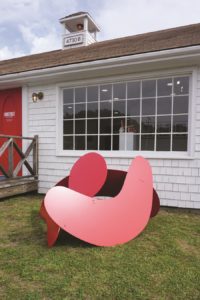
Silver cites Robert Rauschenberg and Marcel Duchamp as influences. “When Mass MoCA hosted Rauschenberg’s The Furlong, the piece wrapped around that entire space into the back rooms, and it was incredible,” he says. “It furthered my aspiration to make something that was bigger than human or bigger than myself, which I’ve still yet to achieve, really.”
But, Silver admits, “not everybody has the space or the finances for a quarter-of-a-million-dollar piece to sit in their yard. I like making prints because they are accessible. There’s something really inviting about them. Having grown up only able to afford prints, that was a way for me to engage with and support artists I liked.”
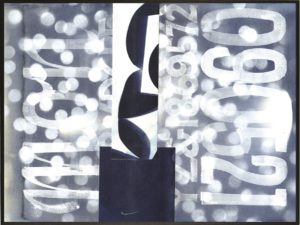
On the other end of the spectrum are objects — like Chuck Taylors or T-shirts — that people can wear or use. Silver tries, however, to keep his art and his other work separate. “I don’t think anybody wants to see my artwork on sneakers,” he says. “If I keep them compartmentalized, they reap the benefits of each other. When I go into my studio, I’m not making something commercial or for anybody else. The sole purpose is for me.
“Ultimately, I’d love to be full-time fine artist,” continues Silver. “Or artist. ‘Fine art’ just sounds old. But I enjoy what I do. I work with really cool people who excite me and give me creative stoke.”
Sometimes, though, there is overlap. “We actually did Warhol shoes a few years ago at Converse,” he says. Silver’s son became fascinated with Warhol’s work. “This is a terrible term, but it’s a great gateway drug: a gateway to understanding art.”
Form and Function
The event: “Form Language,” a show of works by Damion Silver and Kenji Nakayama
The time: Saturday-Sunday, 11 a.m. to 5 p.m.; through Oct. 10
The place: Longstreet Gallery, 4730B Route 6, Eastham
The cost: Free
